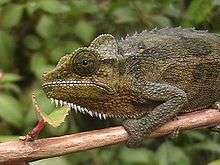Trioceros hoehnelii
Trioceros hoehnelli, commonly known as von Höhnel's chameleon, the helmeted chameleon, and the high-casqued chameleon, is a species of chameleon, a lizard in the family Chamaeleonidae. The species is endemic to eastern Africa.
| Trioceros hoehnelii | |
|---|---|
 | |
| Scientific classification | |
| Kingdom: | Animalia |
| Phylum: | Chordata |
| Class: | Reptilia |
| Order: | Squamata |
| Suborder: | Iguania |
| Family: | Chamaeleonidae |
| Genus: | Trioceros |
| Species: | T. hoehnelii |
| Binomial name | |
| Trioceros hoehnelii (Steindachner, 1891) | |
| Synonyms[2] | |
| |
Etymology
Both the specific name, hoehnelii, and one of the common names, "von Höhnel's chameleon", are in honor of Austrian explorer Ludwig von Höhnel (1857–1942).[3][4]
Identification
Trioceros hoehnelli is a small to medium-size chameleon, growing up to 10 inches in total length (including tail). Coloration is highly variable across its range. During morning hours, it may be seen basking in the sunlight, almost completely black in color to capture heat energy from the sunlight. This species has a single horn on the rostrum, a serrated back crest, and a spiny throat crest.[5] Males are typically larger than females with a larger casque, horn, and enlarged tail base.
Behavior
Most chameleons in east Africa tend to be territorial and the high-casqued chameleon is no different. If males are placed together, they will hiss at each other, turn black, and compress their bodies to make them look larger. Dominant males display brightly colored patterns that differ from females or subordinate males, which often persist until they are defeated during a courtship battle.[6]
T. hoehnelli forms stable pair bonds during the mating season, which endure throughout the five months of pregnancy. After the birth, the pair usually splits up.[7]
The high-casqued chameleon eats most small insects and spiders, and does so by extending the tongue to capture the prey. It is capable of extending the tongue more than a complete body length.
References
- Tolley K (2013). "Trioceros hoehnelii". IUCN Red List of Threatened Species. 2013. Retrieved 26 September 2014.CS1 maint: ref=harv (link)
- "Trioceros hoehnelii ". The Reptile Database. www.reptile-database.org.
- Steindachner F (1891). "Über einege neue und seltene Reptilien- und Amphibien-Arten. Bericht über die von Herrn Linienschiffsleutenant Ritter von Höhnel während der Graf Samuel Telekis ostafrikanischer Expedition gesammelten Reptilien ". Sitzungsb. Akad. Wiss., Wien 100 (1): 291-316 + Plates I-II. (Chamael[e]on höhnelii, new species, pp. 309-311 + Plate I, figures 1, 1a). (in German).
- Beolens, Bo; Watkins, Michael; Grayson, Michael (2011). The Eponym Dictionary of Reptiles. Baltimore: Johns Hopkins University Press. xiii + 296 pp. ISBN 978-1-4214-0135-5. (Chameleo hoehnelii, p. 124).
- Bartlett, Richard D.; Bartlett, Patricia (2005), Chameleons: Everything about Purchase, Care, Nutrition, and Breeding, Barron's Educational Series, p. 73, ISBN 0-7641-2863-9.
- Gans, Carl (1992), Biology of the Reptilia, University of Chicago Press, pp. 350–351, ISBN 0-226-28124-8.
- Toxopeus AG, Kruijt JP, Hillenius D (1988). "Pair-bonding in chameleons". Naturwissenschaften. 75 (5): 268–269. doi:10.1007/BF00378024.CS1 maint: multiple names: authors list (link)
